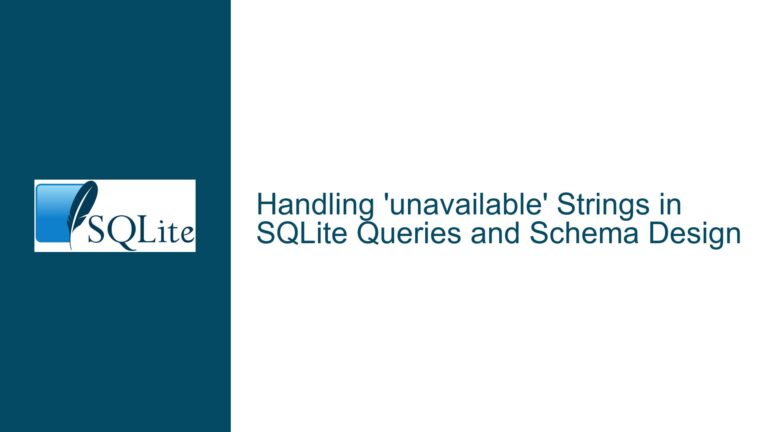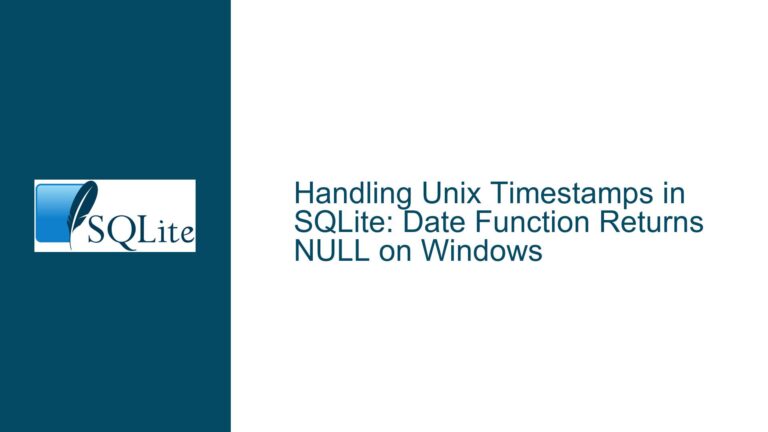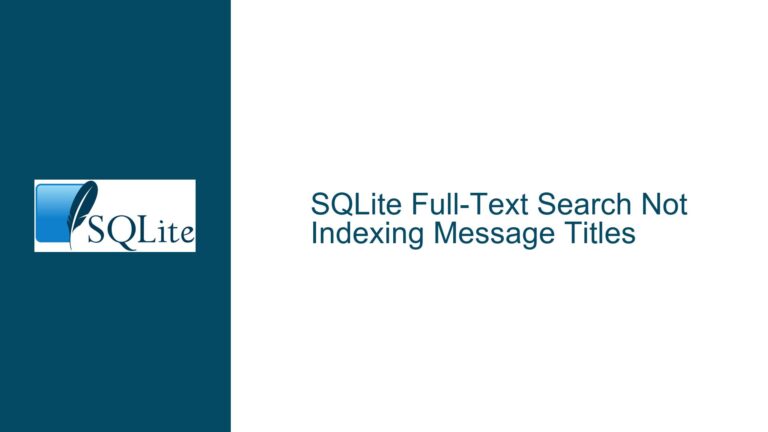Incorrect Query Results Due to Equivalence Transfer Optimization with likely() in SQLite
Issue Overview: Equivalence Transfer Optimization and likely() Function Interaction
The core issue revolves around the interaction between SQLite’s equivalence transfer optimization and the likely() function, which results in incorrect query outputs under specific conditions. Equivalence transfer optimization is a technique used by SQLite’s query planner to simplify and optimize queries by recognizing and leveraging equivalent expressions. This optimization can significantly improve query performance by reducing the complexity of the query execution plan. However, when combined with the likely() function, which is used to provide hints to the query planner about the expected truthiness of a condition, the optimization can produce incorrect results.
The problem manifests when querying tables with specific constraints and conditions. For instance, consider a scenario where two tables, t0 and t1, are created with certain columns and constraints. Table t0 has columns c0 and c1, with c1 being a unique column. Table t1 has a single column c0. When inserting data into these tables and performing a SELECT operation with a NATURAL JOIN or a WHERE clause involving the likely() function, the query returns non-empty results even when the conditions should logically yield an empty result set.
The issue is particularly evident in queries where the likely() function is applied to a condition that involves a comparison between columns from different tables. For example, in the query SELECT ALL * FROM t1 NATURAL JOIN t0 WHERE (likely(t1.c0=t0.c1));, the result set should be empty because there are no rows in t0 where c0 equals c1. However, due to the interaction between the equivalence transfer optimization and the likely() function, the query planner generates an incorrect execution plan that results in non-empty output.
This behavior is not limited to NATURAL JOIN operations. It also occurs in queries involving explicit JOIN conditions and WHERE clauses with multiple conditions. For instance, the query SELECT ALL * FROM t1,t0 WHERE (likely(t1.c0=t0.c1) AND t1.c0=t0.c0); should also return an empty result set, but it does not, further highlighting the issue.
The problem is rooted in the way the query planner estimates the cost of different execution plans. The likely() function influences the cost estimation by suggesting that a particular condition is likely to be true. This suggestion can cause the query planner to choose a suboptimal execution plan that does not correctly account for the equivalence transfer optimization, leading to incorrect results.
Possible Causes: Query Planner Cost Estimation and Equivalence Transfer
The incorrect query results are primarily caused by the interaction between the likely() function and the equivalence transfer optimization in SQLite’s query planner. The likely() function is designed to provide hints to the query planner about the expected truthiness of a condition. When the query planner encounters a condition wrapped in the likely() function, it assumes that the condition is likely to be true and adjusts the cost estimation for different execution plans accordingly.
Equivalence transfer optimization, on the other hand, is a technique used by the query planner to simplify queries by recognizing and leveraging equivalent expressions. This optimization can lead to more efficient execution plans by reducing the complexity of the query. However, when the likely() function is used in conjunction with conditions that involve equivalence transfer, the query planner’s cost estimation can be skewed, leading to the selection of an incorrect execution plan.
The issue arises because the query planner’s cost estimation does not fully account for the implications of the likely() function on the equivalence transfer optimization. The likely() function suggests that a condition is likely to be true, which can cause the query planner to prioritize execution plans that are based on this assumption. However, this prioritization can lead to the selection of a plan that does not correctly handle the equivalence transfer, resulting in incorrect query results.
Another contributing factor is the way the query planner handles the intersection of multiple conditions. In queries where multiple conditions are combined using logical operators such as AND, the query planner must evaluate the cost of different execution plans that satisfy all the conditions. The presence of the likely() function can influence the cost estimation for these plans, potentially leading to the selection of a plan that does not correctly handle the equivalence transfer.
The issue is further compounded by the fact that the likely() function is not a guarantee of the condition’s truthiness but rather a hint to the query planner. This means that the query planner’s cost estimation is based on an assumption that may not hold true in all cases. When this assumption interacts with the equivalence transfer optimization, it can lead to incorrect query results.
Troubleshooting Steps, Solutions & Fixes: Diagnosing and Resolving the Issue
To diagnose and resolve the issue of incorrect query results due to the interaction between the likely() function and the equivalence transfer optimization, several steps can be taken. These steps involve understanding the query planner’s behavior, identifying the root cause of the issue, and applying appropriate fixes or workarounds.
Step 1: Understanding the Query Planner’s Behavior
The first step in troubleshooting the issue is to understand how the SQLite query planner works, particularly in relation to the likely() function and equivalence transfer optimization. The query planner is responsible for generating an execution plan for a given query, and it does so by estimating the cost of different possible plans and selecting the one with the lowest cost.
The likely() function influences the query planner’s cost estimation by suggesting that a condition is likely to be true. This suggestion can cause the query planner to prioritize execution plans that are based on this assumption. However, this prioritization can lead to the selection of a plan that does not correctly handle the equivalence transfer, resulting in incorrect query results.
To gain a deeper understanding of the query planner’s behavior, you can use the .wheretrace command in the SQLite command-line interface (CLI). This command provides additional diagnostic output that can help you see how the query planner is handling the likely() function and equivalence transfer optimization. By analyzing this output, you can identify where the query planner’s cost estimation is going wrong and how it is affecting the execution plan.
Step 2: Identifying the Root Cause of the Issue
Once you have a better understanding of the query planner’s behavior, the next step is to identify the root cause of the issue. In this case, the root cause is the interaction between the likely() function and the equivalence transfer optimization. The likely() function influences the query planner’s cost estimation, causing it to select an execution plan that does not correctly handle the equivalence transfer.
To identify the root cause, you can start by examining the queries that are producing incorrect results. For example, consider the query SELECT ALL * FROM t1 NATURAL JOIN t0 WHERE (likely(t1.c0=t0.c1));. This query should return an empty result set because there are no rows in t0 where c0 equals c1. However, due to the interaction between the likely() function and the equivalence transfer optimization, the query planner generates an incorrect execution plan that results in non-empty output.
By analyzing the query and the query planner’s behavior, you can identify that the likely() function is causing the query planner to prioritize an execution plan that does not correctly handle the equivalence transfer. This prioritization leads to the selection of a plan that produces incorrect results.
Step 3: Applying Appropriate Fixes or Workarounds
Once you have identified the root cause of the issue, the next step is to apply appropriate fixes or workarounds. In this case, the issue has been acknowledged as a bug by the SQLite development team, and a fix has been implemented in the latest version of SQLite (trunk). Therefore, the first and most straightforward solution is to update to the latest version of SQLite that includes the fix.
If updating to the latest version is not immediately feasible, there are several workarounds that can be applied to avoid the issue. One workaround is to avoid using the likely() function in queries that involve equivalence transfer optimization. Instead, you can rewrite the query to avoid the use of likely() or use alternative methods to achieve the same result.
For example, consider the query SELECT ALL * FROM t1 NATURAL JOIN t0 WHERE (likely(t1.c0=t0.c1));. You can rewrite this query to avoid the use of likely() as follows:
SELECT ALL * FROM t1 NATURAL JOIN t0 WHERE (t1.c0=t0.c1);
By removing the likely() function, you can avoid the interaction with the equivalence transfer optimization and ensure that the query planner generates a correct execution plan.
Another workaround is to use explicit JOIN conditions instead of NATURAL JOIN. For example, you can rewrite the query as follows:
SELECT ALL * FROM t1 JOIN t0 ON t1.c0 = t0.c1;
By using an explicit JOIN condition, you can avoid the issues associated with NATURAL JOIN and ensure that the query planner generates a correct execution plan.
In addition to these workarounds, you can also use the .wheretrace command in the SQLite CLI to monitor the query planner’s behavior and ensure that it is generating correct execution plans. By analyzing the diagnostic output provided by .wheretrace, you can identify any issues with the query planner’s cost estimation and take appropriate action to correct them.
Conclusion
The issue of incorrect query results due to the interaction between the likely() function and the equivalence transfer optimization in SQLite is a complex one that requires a deep understanding of the query planner’s behavior. By understanding how the query planner works, identifying the root cause of the issue, and applying appropriate fixes or workarounds, you can ensure that your queries produce correct results.
The SQLite development team has acknowledged the issue and implemented a fix in the latest version of SQLite. Therefore, updating to the latest version is the most straightforward solution. If updating is not immediately feasible, you can apply workarounds such as avoiding the use of the likely() function or using explicit JOIN conditions to avoid the issues associated with NATURAL JOIN.
By following these troubleshooting steps and applying the appropriate solutions, you can resolve the issue and ensure that your SQLite queries produce correct and reliable results.






